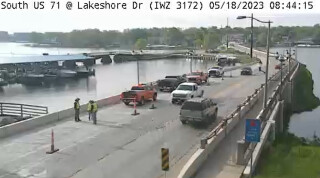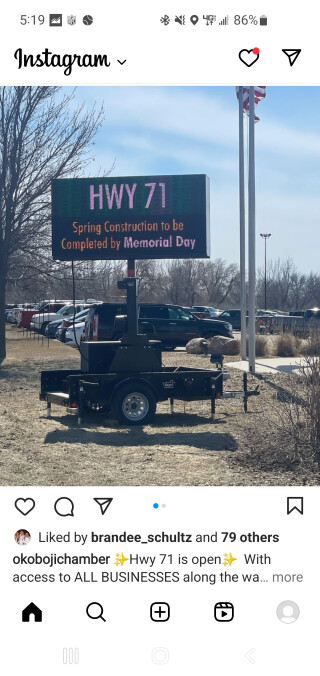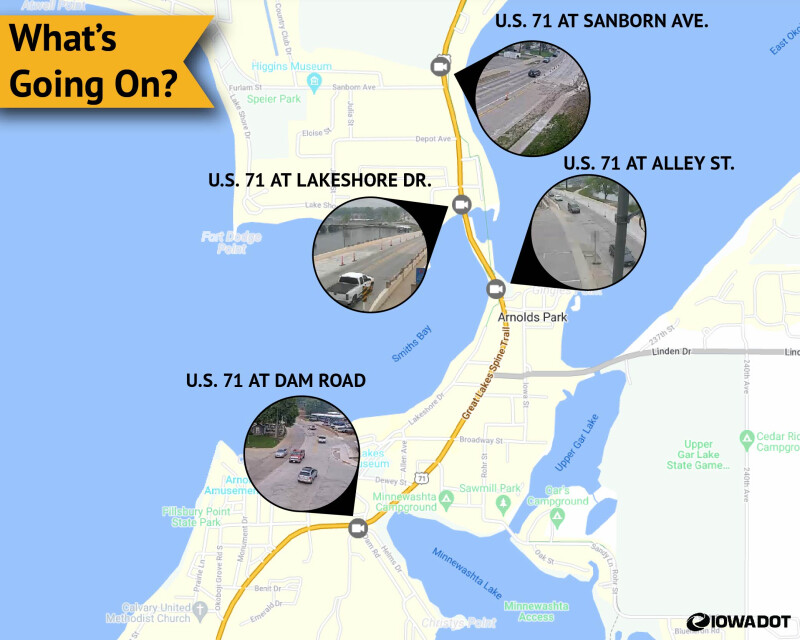It sounds like a recipe for frustration. Major repairs are needed to the main transportation artery through a very popular tourist area. As most Iowans know, the road construction season can be intense because good weather to accommodate work is somewhat limited. The same could be said for the summer water sports season.

Here’s the situation. The pavement on U.S. 71 in Iowa’s Lakes region in Northwest Iowa needs to be replaced and the sidewalks on the causeway, which is a short bridge over the lake, need to be updated with safety barrier rail to protect pedestrians. Most of the impacts are to the towns of Arnold’s Park and Okoboji, home to one of the most popular lake regions in the state.
For the Iowa Department of Transportation to provide excellent customer service, we needed to find a way to get nearly $20 million in construction work done while also minimizing disruption to the tourist season. Our team in the District 3 office in Sioux City ramped up communication with both our contracting partners and the community, with a focus on listening to and taking the needs of those in the area into consideration when staging certain aspects of the project to reconstruct U.S. 71.
Shane Tymkowicz, the assistant district engineer for the area, said, “For many years we’ve used what we call ‘context sensitive design’ where we look at the bigger picture of impacts to the community and not just focus on how to get the project done. The process we used in the Lakes Region takes this even a step further. We looked at the human factor, recognizing that this is a main artery for these cities, and it is going to impact a large group of people and the area businesses.”

Timing is Key
One of the first tasks was to work with the contractors on the project so they understood timelines and considerations for the tourist season. Darwin Bishop, the district construction engineer, worked with Iowa-based Cedar Valley Corp, our prime contractor, to determine that the bulk of the construction work would happen prior to Memorial Day and after Labor Day. In the process, they came up with innovative ideas for staging that would move the project along faster and also involved the use of local subcontractors.
One of the innovations used for the project was to study data on traffic patterns. Data from a system called Wejo was used to compare travel times through the area compared to potential detour routes. This data-driven approach helped us get an idea of how the closures would impact travelers in the area and communicate the impacts of the detours better to our customers.
Communication is Critical
Dakin Schultz, our transportation planner for the area, began working with local businesses, our contracting partners, and the cities of Arnolds Park and Okoboji to identify issues and work through the process.
His communication efforts focused on three elements:
- U.S. 71 through traffic will be detoured to Iowa 86 and Iowa 9. One lane in each direction will be maintained most times on U.S. 71 in Arnolds Park and Okoboji.
- Most intersection construction will be half at a time, to avoid closure of the entire intersection.
- All reconstruction will occur during the spring and fall seasons of 2023 and 2024 to minimize disruption during the area’s peak activity and tourism season.

Tymkowicz said, “We always try to communicate effectively with the communities we serve, but in this instance, the level of detail we shared with the two cities was higher than normal. We wanted to make sure we understood the impact on area businesses and how we could maintain access to those businesses at all times.”
Knowing the area well, Schultz understood that the two cities, while connected geographically, had different ways of communicating. To accommodate the differences, Schultz used paper mailers stuffed with city billing statements to communicate directly with the citizens of Arnold’s Park. For Okoboji residents and businesses, the Chamber of Commerce and Okoboji Tourism used social media and electronic communications and hosted a “kick-off” event. Schultz said, “The response to these updates has been very positive.”
Setting Expectations Early Helps Ease Fears
Part of the project includes shutting down the bridge over the lake after Labor Day for about a month to work on the road and sidewalk safety projects. Tymkowicz said, “This has the potential to impact emergency services for this region. Access to the hospital in Spencer is critical. Working with the EMS community and the contractor, we were able to develop a plan that would maintain access only for emergency vehicles. While some of these conversations are happening in more urban areas around the state, we realize this level of coordination with emergency services is even more critical in rural areas.”
District 3 Engineer Jessica Felix added, “The way we work and interact is changing. These projects don’t happen in a vacuum and lessons learned here can be transferred to other projects. We’re working now to use some of the same outreach elements on three other projects using the U.S. 71 “playbook.” The playbook includes increased communication with area residents including plenty of advanced notice of detours and letting people know how much of a delay they can expect. With our focus on customer service, we want to make the process work for area travelers. It is the unknown that people seem to be most concerned about. From our conversations, everyone understands the need for the projects however, when they have an idea of what to expect, the project doesn’t seem as disruptive.”
